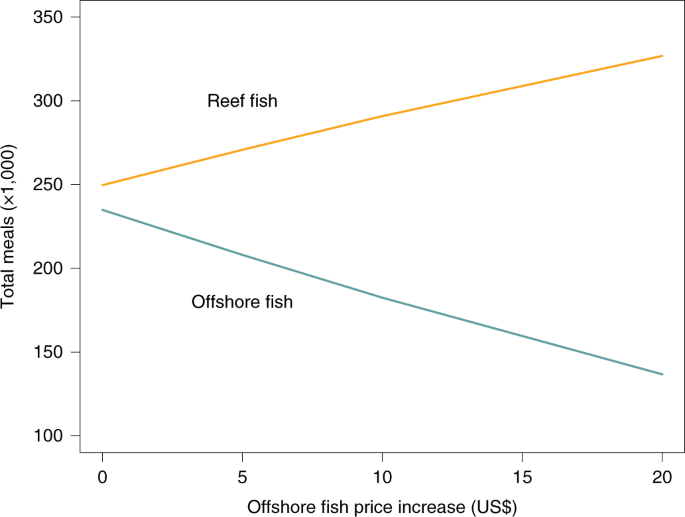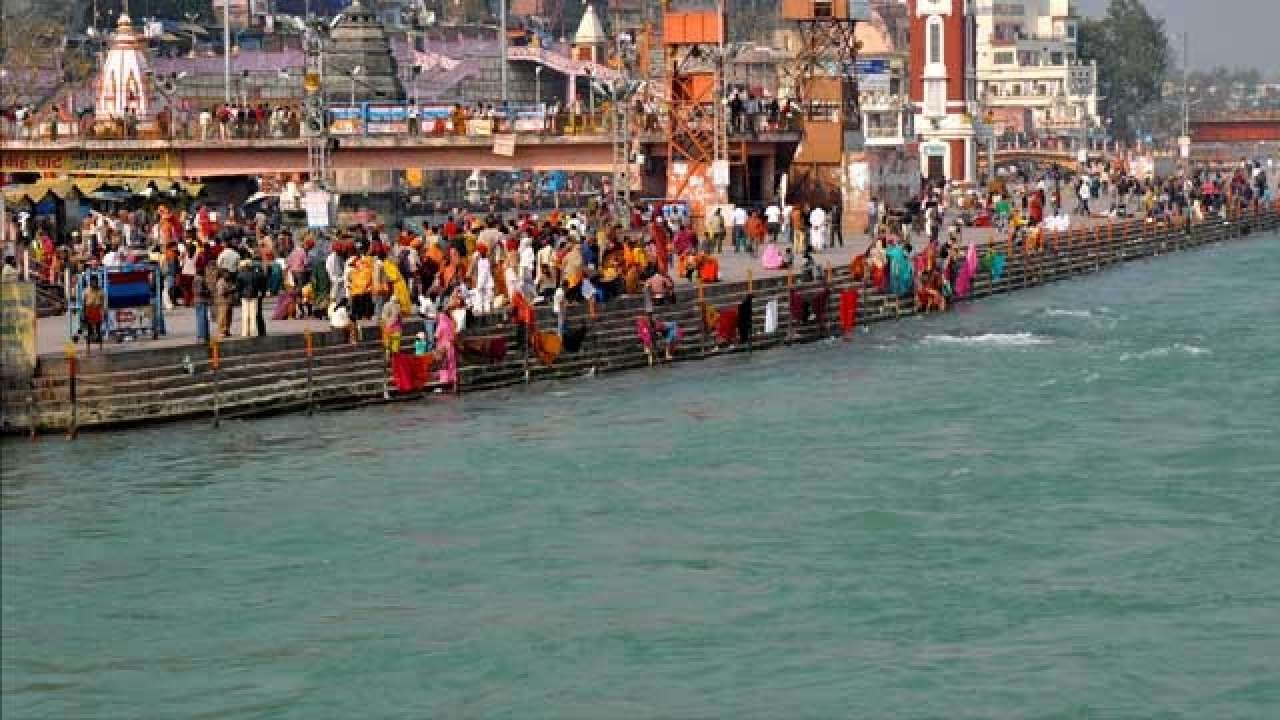
- Select a language for the TTS:
- UK English Female
- UK English Male
- US English Female
- US English Male
- Australian Female
- Australian Male
- Language selected: (auto detect) - EN
Play all audios:
ABSTRACT Understanding the feedbacks between food systems and conservation policies can help avoid unintended environmental consequences. Using a survey-based choice experiment and economic
modelling, we quantify the potential impact of tourists’ responses to a shift in offshore fish supply after the designation of a large-scale marine protected area in Palau. We find that this
conservation policy may increase offshore fish prices and tourists’ consumption of reef fish, thereby further endangering local reef ecosystems. However, if tourists are offered a
sustainable offshore choice, their demand for fish could be kept at current levels, and environmental impacts from increased reef fish consumption would be avoided. Access through your
institution Buy or subscribe This is a preview of subscription content, access via your institution ACCESS OPTIONS Access through your institution Access Nature and 54 other Nature Portfolio
journals Get Nature+, our best-value online-access subscription $29.99 / 30 days cancel any time Learn more Subscribe to this journal Receive 12 digital issues and online access to articles
$119.00 per year only $9.92 per issue Learn more Buy this article * Purchase on SpringerLink * Instant access to full article PDF Buy now Prices may be subject to local taxes which are
calculated during checkout ADDITIONAL ACCESS OPTIONS: * Log in * Learn about institutional subscriptions * Read our FAQs * Contact customer support SIMILAR CONTENT BEING VIEWED BY OTHERS A
GLOBAL ANALYSIS OF CORAL REEF CONSERVATION PREFERENCES Article 31 August 2023 TOWARDS PROCESS-ORIENTED MANAGEMENT OF TROPICAL REEFS IN THE ANTHROPOCENE Article Open access 14 November 2022
MARINE HEATWAVES DISRUPT ECOSYSTEM STRUCTURE AND FUNCTION VIA ALTERED FOOD WEBS AND ENERGY FLUX Article Open access 13 March 2024 DATA AVAILABILITY The authors declare that all of the data
supporting the findings of this study are available within the paper and its Supplementary Information and Supplementary Data files. CODE AVAILABILITY The custom code generated for this
study is available in the Supplementary Data file. REFERENCES * Polasky, S. Planning with feedback effects. _Proc. Natl Acad. Sci. USA_ 103, 5245–5246 (2006). Article ADS CAS Google
Scholar * Ban, N. C. et al. Well-being outcomes of marine protected areas. _Nat. Sustain._ 2, 524–532 (2019). Article Google Scholar * Canavire-Bacarreza, G., Diaz-Gutierrez, J. E. &
Hanauer, M. M. Unintended consequences of conservation: estimating the impact of protected areas on violence in Colombia. _J. Environ. Econ. Manage._ 89, 46–70 (2018). Article Google
Scholar * Grafton, R. Q. et al. The paradox of irrigation efficiency. _Science_ 361, 748–750 (2018). Article ADS CAS Google Scholar * Glamann, J., Hanspach, J., Abson, D. J., Collier,
N. & Fischer, J.The intersection of food security and biodiversity conservation: a review. _Reg. Environ. Change_ 17, 1303–1313 (2017). Article Google Scholar * Garnett, T. et al.
Sustainable intensification in agriculture: premises and policies. _Science_ 341, 33–34 (2013). Article ADS CAS Google Scholar * Balmford, A., Gravestock, P., Hockley, N., McClean, C. J.
& Roberts, C. M. The worldwide costs of marine protected areas. _Proc. Natl Acad. Sci. USA_ 101, 9694–9697 (2004). Article ADS CAS Google Scholar * Ngoc, Q. T. K. Impacts on the
ecosystem and human well-being of the marine protected area in Cu Lao Cham, Vietnam. _Mar. Policy_ 90, 174–183 (2018). Article Google Scholar * Brashares, J. S. et al. Bushmeat hunting,
wildlife declines, and fish supply in West Africa. _Science_ 306, 1180–1183 (2004). Article ADS CAS Google Scholar * Rentsch, D. & Damon, A. Prices, poaching, and protein
alternatives: an analysis of bushmeat consumption around Serengeti National Park, Tanzania. _Ecol. Econ._ 91, 1–9 (2013). Article Google Scholar * Inogwabini, B. I. Bushmeat, over-fishing
and covariates explaining fish abundance declines in the Central Congo Basin. _Environ. Biol. Fishes_ 97, 787–796 (2014). Article Google Scholar * Degarege, G. A. & Lovelock, B.
Sustainable tourism development and food security in Ethiopia: policy-making and planning. _Tour. Plan. Dev._ 16, 142–160 (2019). Article Google Scholar * Wood, L. J., Fish, L., Laughren,
J. & Pauly, D. Assessing progress towards global marine protection targets: shortfalls in information and action. _Oryx_ 42, 340–351 (2008). Article Google Scholar * Toonen, R. J. et
al. One size does not fit all: the emerging frontier in large-scale marine conservation. _Mar. Pollut. Bull._ 77, 7–10 (2013). Article CAS Google Scholar * Smyth, C. & Hanich, Q.
_Large Scale Marine Protected Areas: Current Status and Consideration of Socio-Economic Dimensions_ (Pew Charitable Trusts, 2019). * Gray, N. J. et al. Human dimensions of large-scale marine
protected areas: advancing research and practice. _Coast. Manag._ 45, 407–415 (2017). Article Google Scholar * Lester, S. et al. Biological effects within no-take marine reserves: a
global synthesis. _Mar. Ecol. Prog. Ser._ 384, 33–46 (2009). Article ADS Google Scholar * Gruby, R. L. et al. Policy interactions in large-scale marine protected areas. _Conserv. Lett._
2020, e12753 (2020). Google Scholar * Friedlander, A. M. et al. Size, age, and habitat determine effectiveness of Palau’s marine protected areas. _PLoS ONE_ 12, e0174787 (2017). Article
Google Scholar * Golbuu, Y. & Friedlander, A. M. Spatial and temporal characteristics of grouper spawning aggregations in marine protected areas in Palau, western Micronesia. _Estuar.
Coast. Shelf Sci._ 92, 223–231 (2011). Article ADS Google Scholar * Dacks, R., Lewis, S. A., James, P., Marino, L. L. & Oleson, K. Documenting baseline value chains of Palau’s
nearshore and offshore fisheries prior to implementing a large-scale marine protected area. _Mar. Policy_ 117, 103754 (2020). Article Google Scholar * Carreon, B. Palau’s marine sanctuary
backfires, leading to increased consumption of reef fish. _The Guardian_ (26 February 2020). * Birkeland, C. Working with, not against, coral-reef fisheries. _Coral Reefs_ 36, 1–11 (2017).
Article ADS Google Scholar * Wabnitz, C. C. C., Cisneros-Montemayor, A. M., Hanich, Q. & Ota, Y. Ecotourism, climate change and reef fish consumption in Palau: benefits, trade-offs
and adaptation strategies. _Mar. Policy_ 88, 323–332 (2018). Article Google Scholar * Kemmerly, J. D. & Macfarlane, V. The elements of a consumer-based initiative in contributing to
positive environmental change: Monterey Bay Aquarium’s seafood watch program. _Zoo Biol._ 28, 398–411 (2009). Article Google Scholar * _Palau Responsible Tourism Policy Framework:
2017–2021_ (Bureau of Tourism, 2016). * Brooks, M. E. et al. glmmTMB balances speed and flexibility among packages for zero-inflated generalized linear mixed modeling. _R J._ 9, 378–400
(2017). Article Google Scholar * Bradburn, N. M., Rips, L. J. & Shevell, S. K. Answering autobiographical questions: the impact of memory and inference on surveys. _Science_ 236,
157–161 (1987). Article ADS CAS Google Scholar * Johnston, R. J. et al. Contemporary guidance for stated preference studies. _J. Assoc. Environ. Resour. Econ._ 4, 319–405 (2017). Google
Scholar * McFadden, D. in _Frontiers in Econometrics_ (ed. Zarembka, P.) 105–142 (Academic Press, 1973). * Krinsky, I. & Robb, A. On approximating the statistical properties of
elasticities. _Rev. Econ. Stat._ 86, 715–719 (1986). Article Google Scholar * Loomis, J. What’s to know about hypothetical bias in stated preference valuation studies? _J. Econ. Surv._ 25,
363–370 (2011). Article Google Scholar * Hudson, D., Gallardo, R. K. & Hanson, T. R. A comparison of choice experiments and actual grocery store behavior: an empirical application to
seafood products. _J. Agric. Appl. Econ._ 44, 49–62 (2012). Article Google Scholar * Beck, M. J., Fifer, S. & Rose, J. M. Can you ever be certain? Reducing hypothetical bias in stated
choice experiments via respondent reported choice certainty. _Transp. Res. B Methodol._ 89, 149–167 (2016). Article Google Scholar Download references ACKNOWLEDGEMENTS We thank National
Geographic Pristine Seas for funding this project; the Palau International Coral Reef Center for coordinating and supporting the data collection; the survey enumerators, including A. Uchel
and T. Holm; and T. Oliver for providing advice on our statistical analysis. AUTHOR INFORMATION AUTHORS AND AFFILIATIONS * Stanford University Center for Ocean Solutions, Stanford, CA, USA
Staci A. Lewis * Department of Natural Resource and Environmental Management, University of Hawaii at Manoa, Honolulu, HI, USA Staci A. Lewis, Carlo Fezzi & Kirsten L. L. Oleson *
Department of Economics and Management, University of Trento, Trento, Italy Carlo Fezzi * Land, Environment, Economics and Policy Institute, University of Exeter, Exeter, UK Carlo Fezzi *
School of Life Sciences, University of Hawaii at Manoa, Honolulu, HI, USA Rachel Dacks * University of Siena, Siena, Italy Silvia Ferrini * University of East Anglia, Norwich, UK Silvia
Ferrini * Pacific Community (SPC), Noumea, France Philip A. S. James * Palau International Coral Reef Center, Koror, Palau Lincy Marino & Yimnang Golbuu Authors * Staci A. Lewis View
author publications You can also search for this author inPubMed Google Scholar * Carlo Fezzi View author publications You can also search for this author inPubMed Google Scholar * Rachel
Dacks View author publications You can also search for this author inPubMed Google Scholar * Silvia Ferrini View author publications You can also search for this author inPubMed Google
Scholar * Philip A. S. James View author publications You can also search for this author inPubMed Google Scholar * Lincy Marino View author publications You can also search for this author
inPubMed Google Scholar * Yimnang Golbuu View author publications You can also search for this author inPubMed Google Scholar * Kirsten L. L. Oleson View author publications You can also
search for this author inPubMed Google Scholar CONTRIBUTIONS S.A.L., K.L.L.O. and R.D. planned the project. S.A.L., K.L.L.O., R.D., C.F., S.F and P.A.S.J. designed the study. S.A.L.
K.L.L.O., R.D. and L.M. collected the surveys. C.F., S.A.L., K.L.L.O., R.D. and S.F. conducted the analysis. C.F. and S.F. designed and estimated the choice experiment analysis. S.A.L., C.F.
and K.L.L.O. wrote the paper. R.D., S.F., P.A.S.J., L.M. and Y.G. contributed to the writing. CORRESPONDING AUTHOR Correspondence to Staci A. Lewis. ETHICS DECLARATIONS COMPETING INTERESTS
The authors declare no competing interests. ADDITIONAL INFORMATION PEER REVIEW INFORMATION _Nature Food_ thanks Mark Zimring and Hollie Booth for their contribution to the peer review of
this work. PUBLISHER’S NOTE Springer Nature remains neutral with regard to jurisdictional claims in published maps and institutional affiliations. SUPPLEMENTARY INFORMATION SUPPLEMENTARY
INFORMATION Survey instrument, Supplementary Figs. 1–5 and Supplementary Tables 1–12. REPORTING SUMMARY SUPPLEMENTARY DATA Data and code for the choice experiment calculations, WTP
modelling, demographics analysis and consumption calculations. RIGHTS AND PERMISSIONS Reprints and permissions ABOUT THIS ARTICLE CITE THIS ARTICLE Lewis, S.A., Fezzi, C., Dacks, R. _et al._
Conservation policies informed by food system feedbacks can avoid unintended consequences. _Nat Food_ 1, 783–786 (2020). https://doi.org/10.1038/s43016-020-00192-7 Download citation *
Received: 20 March 2020 * Accepted: 21 October 2020 * Published: 30 November 2020 * Issue Date: December 2020 * DOI: https://doi.org/10.1038/s43016-020-00192-7 SHARE THIS ARTICLE Anyone you
share the following link with will be able to read this content: Get shareable link Sorry, a shareable link is not currently available for this article. Copy to clipboard Provided by the
Springer Nature SharedIt content-sharing initiative






